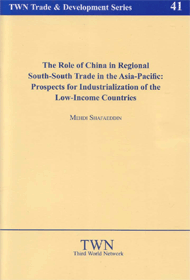|
|
|||
ABOUT THE BOOK Based on his proposed alternative theoretical framework for South-South trade as a vehicle for industrialization and development and refuting the “decoupling” thesis – that is, that East Asian countries are decoupled from the business cycle in developed countries – the author analyzes the merits and shortcomings of China’s regional trade with its partners. Moreover, considering the growing weight of China in the global production network and international trade, he proposes policies for the industrialization and development of the partner countries in the context of strengthening China’s role as a growth “pole”. He suggests, inter alia, the need for industrial collaboration among the low-income countries of the region – which benefit less than others from the dynamics of the Chinese economy as a “hub” – complemented by adjustment assistance by China and the newly industrializing economies (NIEs). He also proposes technological cooperation among China’s trading partners which are currently involved in production sharing in a limited number of electrical and electronic products for export to third markets in developed countries. Such cooperation would be aimed at upgrading their industrial structure and reducing their vulnerability to changes in the economic strategy of China and to the business cycle in the developed countries. ABOUT THE AUTHOR MEHDI SHAFAEDDIN is a development economist, former head of the Macroeconomics and Development Policies Branch at the United Nations Conference on Trade and Development (UNCTAD), and author of many articles on industrialization and development policies in international journals. His books include Trade Policy at the Crossroads: The Recent Experience of Developing Countries (Palgrave Macmillan, 2005) and Competitiveness and Development (Anthem Press, forthcoming, September 2012). He can be contacted at M.Shafaeddin@gmail.com or M.Shafaeddin@Shafaeddin.com. Contents 1 Introduction 2 China as a Regional Industrial “Pole” China’s economic dynamism and trade performance Structure of China’s imports Nature of production sharing and its role in East Asian trade The role of China in regional production sharing Lack of integration of low-income countries 3 Vulnerability of ESSEA Countries, or Decoupling? Short/medium-run risks Long-run risks 4 The Future of Regional Trade: The Questionable Role of the Market Policy implications for the future of industrialization in the ESSEA region 5 Concluding Remarks Endnotes References PRICE POSTAGE Malaysia RM7.00 RM1.00 Third World countries US$4.00 US$2.00 (air); US$1.00 (sea) Other foreign countries US$6.00 US$2.00 (air); US$1.00 (sea) (For orders of more than 3 copies, please write in for reduced postal rate) How to Order the Book Visit our TWN Online Bookshop at: www.twnshop.com or contact Third World Network at 131 Jalan Macalister, 10400 Penang, Malaysia. Website: www.twn.my Tel: 604-2266159 Fax: 604-2264505 Email: twnet@po.jaring.my for further information.
|
|||

